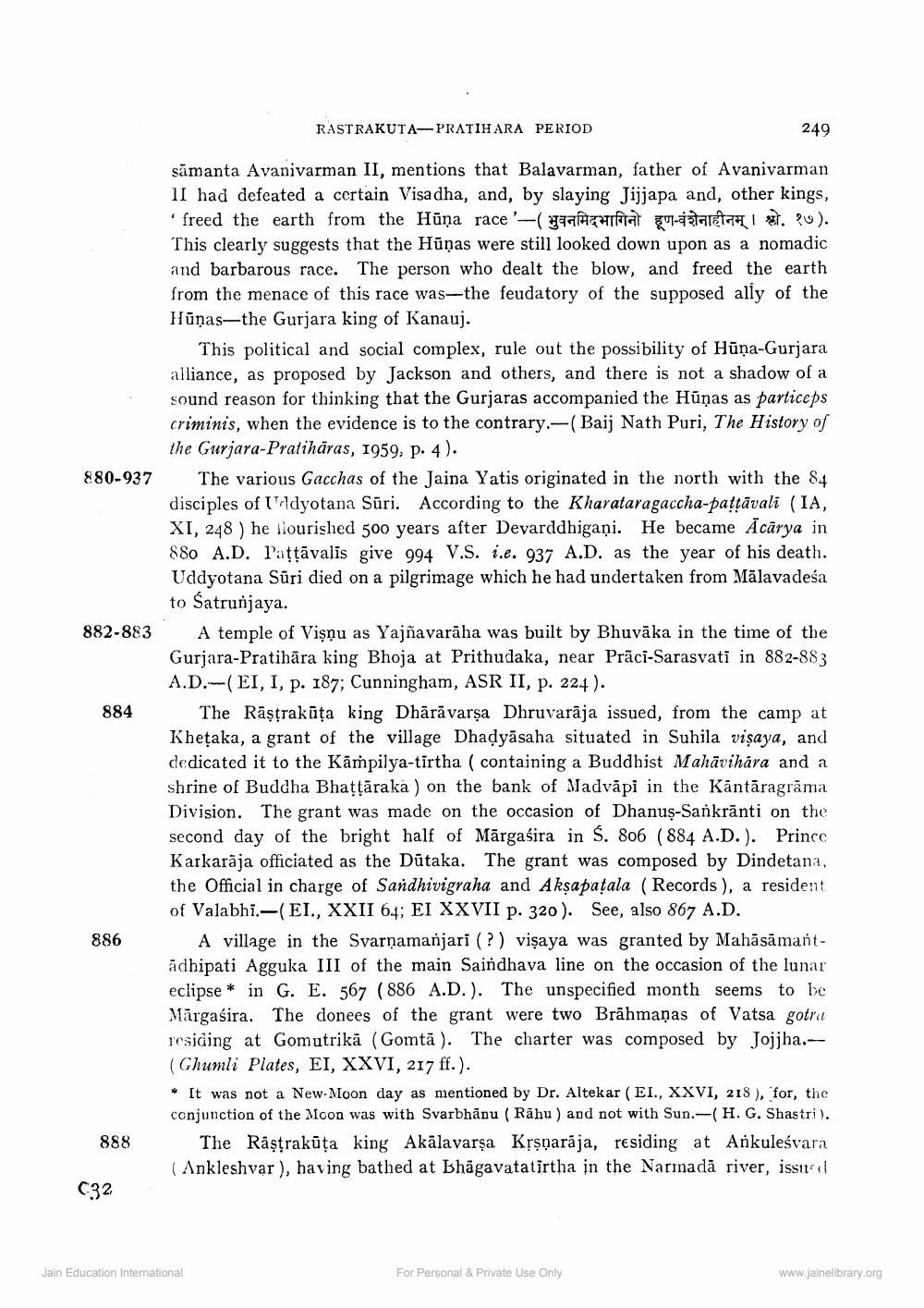________________
RASTRAKUTA-PRATIHARA PERIOD
249
880-937
882-883
sāmanta Avanivarman II, mentions that Balavarman, father of Avanivarman II had defeated a certain Visa dha, and, by slaying Jijjapa and, other kings, 'freed the earth from the Hūņa race'-( UTAHAT 20-43areta! ?9). This clearly suggests that the Hūņas were still looked down upon as a nomadic and barbarous race. The person who dealt the blow, and freed the earth from the menace of this race was-the feudatory of the supposed ally of the Hūņas—the Gurjara king of Kanauj.
This political and social complex, rule out the possibility of Hūņa-Gurjara alliance, as proposed by Jackson and others, and there is not a shadow of a sound reason for thinking that the Gurjaras accompanied the Hūņas as particeps criminis, when the evidence is to the contrary.-(Baij Nath Puri, The History of the Gurjara-Pratihāras, 1959, p. 4).
The various Gacchas of the Jaina Yatis originated in the north with the 84 disciples of Udyotana Sūri. According to the Kharataragaccha-pattāvali (IA, XI, 248 ) he flourished 500 years after Devarddhigaại. He became Acārya in 880 A.D. lattāvalis give 994 V.S. i.e. 937 A.D. as the year of his death. Uddyotana Sūri died on a pilgrimage which he had undertaken from Mälavadesa to Šatrunjaya.
A temple of Vişnu as Yajñavarāha was built by Bhuvāka in the time of the Gurjara-Pratihāra king Bhoja at Prithudaka, near Prāci-Sarasvati in 882-883 A.D.-(EI, I, p. 187; Cunningham, ASR II, p. 224).
The Rāştrakūta king Dhārāvarsa Dhruvarāja issued, from the camp at Khețaka, a grant of the village Dhadyāsaha situated in Suhila visaya, and dedicated it to the Kämpilya-tirtha ( containing a Buddhist Mahāvihara and a shrine of Buddha Bhattāraka ) on the bank of Madvāpi in the Kāntāragrāma Division. The grant was made on the occasion of Dhanus-Sankrānti on the second day of the bright half of Mārgasira in $. 806 (884 A.D.). Prince Karkarāja officiated as the Dutaka. The grant was composed by Dindetana, the Official in charge of Sandhivigraha and Akşapatala (Records ), a resident of Valabhi.-(EI., XXII 64; EI XXVII p. 320). See, also 867 A.D.
A village in the Svarṇamanjari (?) vişaya was granted by Mahāsāmantadhipati Agguka III of the main Saindhava line on the occasion of the lunar eclipse * in G. E. 567 ( 886 A.D.). The unspecified month seems to be Mārgasira. The donees of the grant were two Brāhmaṇas of Vatsa gotru residing at Gomutrikā (Gomtā). The charter was composed by Jojjha.(Ghumli Plates, EI, XXVI, 217 ff.). * It was not a New Moon day as mentioned by Dr. Altekar (EI., XXVI, 218 ), 'for, the conjunction of the Moon was with Svarbhānu ( Rāhu ) and not with Sun.-(H. G. Shastri).
The Râştrakūta king Akālavarşa Krşparaja, residing at Ankuleśvara (Ankleshvar ), having bathed at Bhagavatatirtha in the Narmadā river, issus
884
886
888
C32
Jain Education Intemational
For Personal & Private Use Only
www.jainelibrary.org




